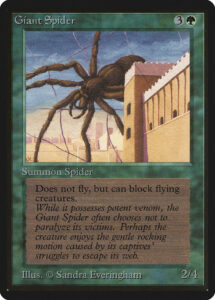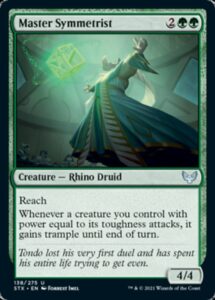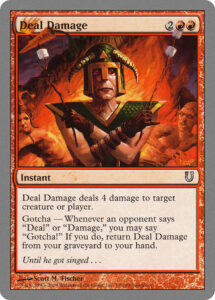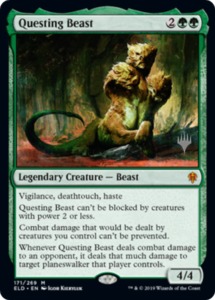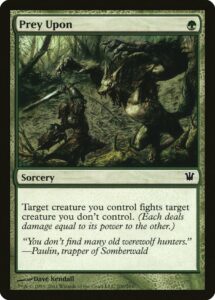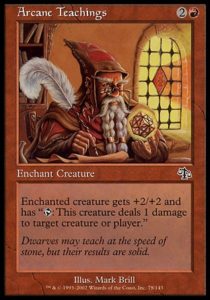My favorite quote about design belongs to Antoine de Saint-Exupéry:
A designer knows they have achieved perfection not when there is nothing left to add, but when there is nothing left to take away.
Game designers know and eternally struggle with this rule. We fall in love with the mechanic that proves a prototype is worth pursuing, only to eventually (and painfully) discard the mechanic once the rest of the game catches up and no longer needs it. We notice when games fail to streamline and suffer from overcomplication and unbalance. Magic is no different: countless cards and mechanics never see print despite being internally beloved. But Magic is different from all other games due to how longstanding and changing it is. Mechanics like Prowess, Intimidate, and Shroud rose to prominence and later lost their evergreen status.
Let’s consider one of Magic’s oldest mechanics, Reach. It’s not one of Magic’s sexier evergreen keyword mechanics, but it’s an ancient workhorse. Reach has been around since Alpha’s Giant Spider in 1993, yet was only keyworded in 2007’s Future Sight. But longevity does not justify survival. Does Magic still need Reach?
Pro: Reach Does Good Work
Before considering why Reach’s time might be worth ending, let’s consider all the good work Reach does. To talk about that, we need to talk about Flying.
Flying is Magic’s best mechanic. It’s simple, clean, and so resonant that it’s usually the first keyword new players learn. It’s the fundamental evasion mechanic and the most used keyword mechanic in the game. It exists in every set and is accessible by every color (though green gets it by far the least).
Flying is so ubiquitous that every color needs to be able to interact with flying creatures. Blocking and removal spells are the most common answers, yet green has always had the fewest flying creatures to block with and the worst creature interaction (until the creation of Fight in 2011’s Innistrad). Therefore, it gets Reach. Reach is far weaker than Flying, but a few Reach creatures here and there can keep Flying in check. Flying is still outstanding, but it doesn’t mean unblockable against most red-green decks.
Con #1: That has Reach?!
It doesn’t take long to learn that Spiders basically always have reach, along with most creatures holding bows. But beyond that, it’s generally unclear whether or why a creature has reach. We’re two weeks into Strixhaven draft and my opponents are still attacking their creatures into Master Symmetrist, Scurrid Colony, and Cogwork Archivist—and emoting “oops” when I block and eat their attacker.
You might argue that’s it unfair to single Reach out for artwork issues. First Strike isn’t limited to humanoids wielding weapons, and I couldn’t begin to tell you what obviously communicates Vigilance. However, one mechanic is (almost) always clearly communicated via art: Flying. Creatures with Flying are flying in their artwork. Creatures that don’t are not. The few times Magic’s slipped up here, player mistakes abound. As game designers, we owe it to our players not to trick them and to let cards align with intuition. If Flying always needs to be communicated via art, and Reach exists solely to counter Flying, Reach should likewise always be communicated via art.
However, making Reach artistically consistent isn’t easy. It requires every world to have spiders or archers. It requires archers to always have Reach and for bows to only be prominently featured in art on Reach creatures or on noncreatures. And this strategy isn’t exactly foolproof; while Flying is intuitive to newer players, “Spiders and Archers stop fliers” lacks such clear resonance.
In and of itself, this argument isn’t enough to convince me that Magic doesn’t need Reach, but it’s the most consistent reminder that Reach causes problems.
Con #2: Defensive Surprise
Many of Magic’s evergreen mechanics are somewhat forgiving of error. If you try to single block a Menace creature or target something with Hexproof, your opponent (or Magic Arena) will let you know you’ve made a mistake and let you try again. Other mechanics put the onus on your opponent to demonstrate them for you: they leave an attacking Vigilance creature untapped or attack with a haste creature the turn they play it.
Mechanics like First Strike, Deathtouch, and Reach don’t follow these trends: they both punish error and do not signal their own use. However, Reach is the only surprise mechanic that functions solely on defense. You need to keep opposing creatures’ First Strike and Deathtouch in mind constantly, but Reach only matters when you’re attacking them. Moreover, Reach only matters if you have Flying creatures, so it’s easy to overlook Reach before you’ve played a flier and never adjust your evaluation.
You might ask why it’s a problem for Reach to only function while blocking when mechanics like Menace, Vigilance, and Haste only function while attacking. The reason is simple: games need to end. Mechanics that reward aggression push towards a satisfying conclusion before the game has gotten stale. Reach can only prolong games by stymieing aggression but never shorten them. I’m not convinced that Magic needs to constantly use such a mechanic, particularly when it’s one of the easiest keywords to be surprised and punished by.
Con #3: The Questing Beast Conundrum
Magic is a game of relatively small numbers. This makes math simpler, and that’s a serious boon once a battlefield gets even remotely complicated and players have to calculate whether and how to attack. However, small numbers present a challenge when costing cards, especially cards that are intended for heavy Standard play—you can’t make a creature cost 3.75 mana. (Editor’s note: Not yet, at least.) So, one easy solution is to add a keyword, and Reach is perhaps the least expensive evergreen keyword to tack on (other than Defender, which is a downside). This is how we get cards like Robber of the Rich, Stonecoil Serpent, and Gemrazer, cards that attack so often it’s easy to miss Reach hidden in their text boxes.
One could argue that the problem here isn’t with Reach, but with Wizards squeezing too much extra value into creatures through keywords. I agree, but this approach reveals a subtler problem: what does Reach cost? If Flying adds about one mana to a creature’s cost, Double Strike adds 1.5, and Vigilance has a mana value of ~0.25, does Reach add any significant cost at all? Is it just free? If Reach is so minor an ability in costing as to not add anything, does Magic still need it?
Creatures have steadily gotten bigger over time and keywords have gradually gotten cheaper—consider that Frost Trickster isn’t one of the best blue commons when over ten years ago, Wind Drake was often among blue’s best common creatures. Perhaps Reach costing an insignificant amount of mana is evidence that the game no longer needs it—Flying is a little bit worse than it used to be and might no longer need Reach to keep it in check. Squeezing Reach onto creatures might not be necessary, and having a free ability may only be exacerbating the trend of appending more text onto creatures.
Con #4: Green has more tools
One of the main reasons Reach persisted across the years is that green needed it. It had scant removal and fewer fliers, making it especially weak to Flying. Much has changed. Plummet replaced Wing Snare and was then supplanted by cards like Broken Wings, giving green consistent access to effective Flying hate. The advent of Fight made it so that green now has access to quality creature interaction.
Add in the sheer amount of card smoothing and card advantage green now has access to and it’s no longer the color that once struggled to answer Aven Windreader. Green has the tools to deal with Flying creatures without relying on Reach. If you took Reach away, there would be enough to fill the gap.
I love Giant Spider. I have plenty of nostalgia for Reach. The mechanic has long done good work as a workhorse mechanic. But perhaps it’s time to try putting it to pasture, at least for a bit. Magic has gained a few evergreen keywords with the return of Protection and the introduction of Ward; it could stand to bench a keyword to keep the cognitive load down. And even if Reach did go away, there’s nothing stopping Wizards printing a Reach creature or two without using the keyword. They do it all the time with non-evergreen keywords—and this way, it’d take up enough real estate in the text box that players are less liable to miss it.
Zachary Barash is a New York City-based game designer and the commissioner of Team Draft League. He designs for Kingdom Death: Monster, has a Game Design MFA from the NYU Game Center, and does freelance game design. When the stars align, he streams Magic (but the stars align way less often than he’d like).


